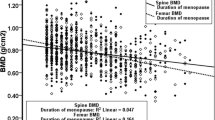Abstract
The aim of this study is to understand the current status of bone mineral density (BMD) among Taiwanese women and to determine the relationship between bone mass, weight, height and body mass index (BMI), and the proportion of osteoporosis sufferers, based on World Health Organization standards, in each age group. A total of 4689 women underwent lumbar vertebrae (L2–L4) BMD measurements, and 3529 women underwent femoral neck bone mineral density measurements. BMD was measured using dual-energy X-ray absorptiometry. Standards were based on the BMD of the 20- to 40-year-old age group, as were relationships between height, weight, BMI, and BMD. Pearson correlation revealed a positive relationship between body weight, BMI, and BMD in the femoral neck; other correlations were insignificant. The defined BMD value for a diagnosis of osteoporosis was 0.827 g/cm2 for lumbar vertebrae and 0.605 g/cm2 for the femoral neck. The proportion of osteoporosis calculated for each age group in the lumbar vertebrae group was: 40–49 years old, 8.25%; 50–59 years old, 8.62%; 60–69 years old, 14.14%; 70–79 years old, 14.25%; >80 years old, 16.07%. For the femoral neck group, the values were: 40–49 years old, 5.24%; 50–59 years old, 5.28%; 60–69 years old, 11.17%; 70–79 years old, 17.30%; >80 years old, 24%. The total proportion of osteoporosis in the lumbar vertebrae was 10.08%, and in the femoral neck, 7.45%. The BMD of Taiwanese women shows a positive relationship to body weight and BMI in the femoral neck group but not in the lumbar vertebrae group. The proportion of osteoporosis by age group in this cohort was lower than that among Western women.
Similar content being viewed by others
References
Charles W, Slemenda C, Johnston C Jr (1999) Epidemiology of osteoporosis. In: Lobo RA (ed) Treatment of the postmenopausal women: basic and clinical aspects. Lippincott Williams & Wilkins, Baltimore, pp 279–285
Riggs BL (1992) The problem of osteoporosis—its prevention and treatment. In: Riggs BL (ed) Prevention and treatment of osteoporosis. Hogrefe & Huber, Lewiston, N.Y., pp 9–11
Lindsay R (1995) The burden of osteoporosis: cost. Am J Med 98:9s–11s
WHO Study Group (1994) Assessment of fracture risk and its application to screening for postmenopausal osteoporosis. World Health Organization, Switzerland
Yang T.-S. et al. (1990) Bone mineral density in Taiwanese women. J Obstet Gynecol ROC 29:261–264
Yang T.-S. et al. (1990) Quantitative computed tomography of lumbar spine in menopausal women. J Obstet Gynecol ROC 29:265–268
Delmas PD (1992) Bone mass measurement for assessing the risk of osteoporosis. In: Riggs BL (ed) Prevention and treatment of osteoporosis. Hogrefe & Huber, Lewiston, N.Y., pp 12–20
Kanis JA, Melton LJ III, Christiansen C, Johnston CC, Khaltaev N (1994) The diagnosis of osteoporosis. J Bone Miner Res 9:1137–1141
Ho SC, Lau EM, Woo J, Sham A, Chan KM, Lee S, Leung PC (1999) The prevalence of osteoporosis in the Hong Kong Chinese female population. Maturitas 32:171–178
Mazess RB, Barden H (1999) Bone density of the spine and femur in adult white females. Calcif Tissue Int 65:91–99
Cummings SR, Cauley JA, Palermo L et al. (1994) for the study of the Osteoporotic Fractures Research Group. Racial differences in hip axis lengths might explain racial differences in rates of hip fractures. Osteoporos Int 4:226–229
Fugh-Berman A (1999) Complementary medicine: herbs, phytoestrogens, and other treatments. In: Lobo RA (ed) Treatment of the postmenopausal woman: basic and clinical aspects. Lippincott Williams & Wilkins, Baltimore, pp 453–459
Author information
Authors and Affiliations
Corresponding author
Rights and permissions
About this article
Cite this article
Yang, TS., Chen, YR., Chen, YJ. et al. Osteoporosis: prevalence in Taiwanese women. Osteoporos Int 15, 345–347 (2004). https://doi.org/10.1007/s00198-003-1509-x
Received:
Accepted:
Published:
Issue Date:
DOI: https://doi.org/10.1007/s00198-003-1509-x




